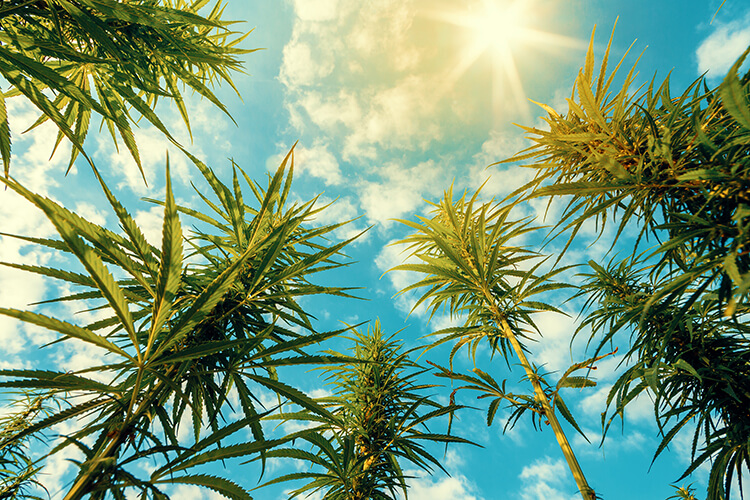Hemp
Good for People, Great for the Planet: The Healing Potential of Hemp
With Earth Day this month, it’s the perfect time to celebrate the beauty and power of nature—including our favorite plant: hemp! Hemp has recently emerged from its prohibition with well-deserved fanfare and we’re eager to share some of the numerous (and sometimes surprising) ways that it can be used to help build a more environmentally sustainable world.
Many people hadn’t heard about hemp until the modern cannabis and CBD industries emerged, but the truth is, hemp has been cultivated for its strong fibers for over 10,000 years. It was discovered in rope on pottery in ancient China, where it was also used in paper and bow strings. The Japanese and Arabs learned about it from the Chinese, and then hemp made its way to Europe and colonial America. By the mid-1600s, hemp was an economic staple with the Colonies producing cordage, cloth, canvas, sacks and paper during the years leading up to the Revolutionary War. The first drafts of the Declaration of Independence were penned on hemp paper. Hemp fiber was so important to the young Republic that farmers were compelled by patriotic duty to grow it and were allowed to pay taxes with it. George Washington grew hemp and encouraged all citizens to sow hemp widely. Thomas Jefferson bred improved hemp varieties and invented a special brake for crushing the plant’s stems during fiber processing.
What is it about hemp that’s causing many people to refer to it as a “wonder crop?” Relatively easy to grow, industrial hemp can thrive in most conditions. It requires about half of the water and acreage needed to grow cotton and doesn’t need much to protect it from pests and diseases. Factor in its ability to sequester carbon from the air and return nutrients to the soil from which it grows, and it’s easy to understand why farmland dedicated to hemp production in the United States has multiplied exponentially (by about 100 times, according to the USDA) over the last five years alone.
Not only is the footprint of hemp much smaller than other widely used crops, but its use potential is vast and impressive. Tall, sturdy hemp plants can be used to make clothing, rope, shoes, paper, bioplastics, biofuels, and building materials that require a fraction of the resources we’ve been dedicating to other sources of those goods until recently.
Hempcrete, a concrete-like material made of hemp and lime, has already proven to be an energy-efficient, breathable, mold-resistant, versatile material that could replace the plastics and plasters currently used by homebuilders. If widely adopted, it could revolutionize construction during a time when the demand for eco-friendly infrastructure is steadily climbing.
It’s more than just the fibers of hemp that can be put to use. Hemp seeds provide a nutrient-dense food source rich in fatty acids, vitamins and minerals that can be consumed raw, hulled, or in other forms such as milk, protein powder, flour, and salad dressing. Oil made from hemp seeds has moisturizing, nourishing, and anti-inflammatory properties that nourish hair and skin, making it a great ingredient for lotions, soaps, shampoos, lip balms, and much more.
One of the greatest gifts bestowed by hemp is the high levels of cannabidiol (CBD) present in its flowers. Anxiety, depression, PTSD, inflammation, insomnia, migraines, and seizures are among the ailments now shown to be reduced or improved by activating endocannabinoid receptors in the bodies of humans and animals alike through high-CBD hemp extracts. Additionally, these benefits are realized without the side effects associated with common pharmaceuticals or the psychotropic effects of another well-known cannabinoid THC, high levels of which are within the flowers of marijuana plants.
Perhaps one of the most large-scale opportunities for hemp to demonstrate its utility is in the area of textiles. Approximately 20 million tons of cotton are produced around the world annually, accounting for over 30% of fiber requirements. Switching to hemp could have significant environmental impact for a multitude of reasons including:
REDUCED Land Use: Cotton requires twice as much land per ton of finished textile compared to hemp, so we could meet the same demand while saving half of the acreage currently used. Hemp also returns nutrients to the soil from which it grows and sequesters carbon dioxide out of the air, two sustainably useful traits that aren’t shared with cotton.
REDUCED Water Consumption: For each kilogram of usable fiber, cotton requires over 10,000 liters of water while hemp needs 2,123 liters according to a 2005 study published by the Stockholm Environment Institute. Other studies have hemp’s water consumption at 50% of what cotton needs, so hemp is the clear winner even granting cotton the more generous estimates.
REDUCED Pesticides: 25% of the planet’s pesticide use is on conventional cotton fields while hemp is naturally pest-resistant and requires little to no insecticides.
Hemp bioplastics are made from hemp stalks that provide a very high cellulose count, around 70%—the element needed to produce plastic; it can also be heated and put under pressure to produce nanocellulose, a gel like plastic product. Lego’s bricks as we know them will be a thing of the past. The company is now looking to replace the plastic bricks with a more environmentally friendly material and hemp bioplastic could offer a solution. Using hemp for sturdy composites is nothing new—Henry Ford who was a big advocate hemp, made a prototype car in 1941 that had a body made from a hemp composite.
Hemp can also provide two sustainable alternatives to fossil fuels: hemp biodiesel, made from the oil of the (pressed) hemp seed and hemp ethanol/methanol, made from the fermented stalk. A conversion to hemp as a renewable fuel source would do wonders to help restore the planet’s health by protecting biodiversity, preventing senseless fracking and stabilizing climate change by reducing air pollution.
In the age of conscious consumerism and a heightened awareness of what environmental impacts are attached to our purchasing decisions, choosing hemp could revolutionize multiple industries and create a more sustainable future for our planet. If you’re interested in learning more, Kaya Hemp Co., located in Central Phoenix, is committed to supporting the resurgence of this “wonder crop” by offering a curated selection of unique and eco-friendly hemp products for people and pets, including premium CBD products.

